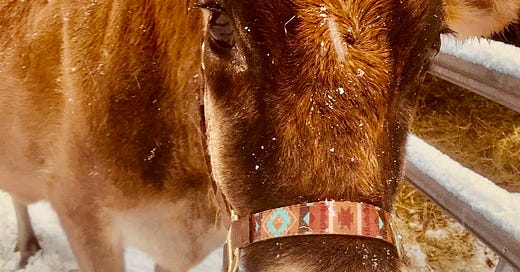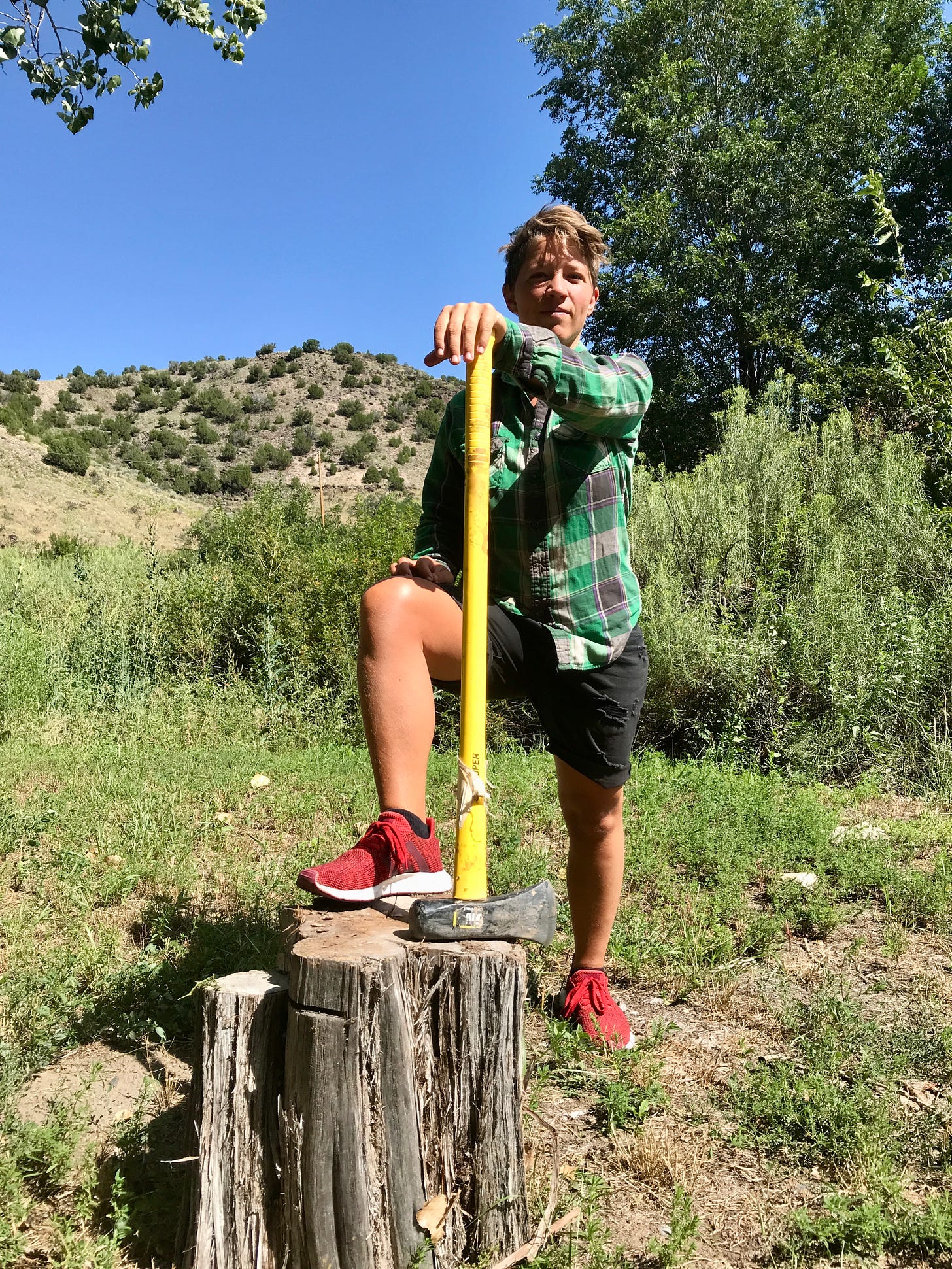Listen to this post on the Eat Heal Farm Podcast
Before Loui Pasteur’s presumptuous discovery of pasteurization, most milk was left out to sour (aka culture, aka ferment). After the morning milking of the family cow, sheep, goat, or water buffalo, milk was left at room temperature without concern of spoiling, going off, or becoming laden with harmful bacteria.
I know this goes against everything we’ve been taught about raw dairy - cool it asap or you will be struck down with E.coli or Listeria. The FDA doesn’t tell you that the only way your gut and immune system suffer from pathogenic bacteria infection from raw milk is if the cow’s udders weren’t washed properly before milking. Or, if the cow sat in her manure for hours without being washed. Good ol’ fashion soap and water are all that’s needed to create a clean milk product.
Unlike modern dairies, our ruminant milking ancient ancestors didn’t quickly rush their fresh, warm morning milk to cold storage. Nor was the milk bucket placed in an icy cold river to quickly cool. Nor was it ushered into a temperature-controlled sterile room, where walls are painted white, and floors are concrete—the FDA standard milk facility regulations modern day.
This is not a lie; you cannot get a license to sell raw milk (at least not in New Mexico) unless you have a designated milk building where the walls are painted white—of course, there are even more ludicrous and much more expensive requirements to obtaining a license for selling raw milk that has absolutely nothing to do with creating a clean, wholesome milk product. And, the cost to do so is well over $20K. For some reason, they don’t offer subsidies to raw milk farmers…
Back to clabber…
Of course, our ancient ancestors weren’t worried about keeping milk cold for many reasons…
For one, it wasn’t on their radar. Nobody threatened to shut down their farm or imprison them for not abiding by “safe” milk practices.
For two, our ancient ancestors ingeniously knew that soured milk was healthy, delicious, and resourceful—souring fresh milk would extend shelf-life, enhance nutrition content, and make its nutrients more bioavailable. And, shockingly the result was not a society laden with foodborne illness but a robust and hearty culture nourished by delicious, flavorful, probiotic-rich soured milk including, yogurt, kefir, cheese, butter, sour cream and, clabber.
If you’re unfamiliar with clabber or clabbered milk don’t worry, you’re not alone. Most people have no idea what clabber is (I’ve been there).
Unfortunately, clabber became long forgotten when its more sought-after cultured dairy cousins, yogurt and kefir, came along. Like yogurt and kefir, clabber is fermented milk. However, it’s much simpler to make, less volatile if left on the counter and forgotten (unlike kefir and yogurt, which can become explosive due to overfermentation), and teeming with beneficial bacteria and enzymes. Most importantly, it’s absolutely delicious.
When you leave milk at room temperature for 24-48 hours, the natural beneficial bacteria in milk cause it to curdle and ferment. As the milk clabbers (thickens), the cream rises to the top and develops into a cross between sour cream and crème fraîche, while the bottom milk layer transforms into a thick yogurt-like substance.
The only ingredient you need to make clabbered milk is milk. Preferably raw and preferably cow-warm but any milk will do.
Cow-warm: milk that’s fresh from the udder and right around 101°F-102°F.
Milk proteins (casein) must be cow-warm to transform into cheese, yogurt, or clabber. Milk thrives in the correct environment ranging from room temperature to 102.2°F. When milk is left at these temperatures, it inherently creates its own beneficial microbial and enzymatic world. And, the more beneficial bacteria present, the stronger the milk defense system meaning pathogenic bacteria cannot survive in the presence of beneficial bacteria. So, even if you forget about your clabber and leave it out for a few days you’ll get a stronger probiotic substance with a whole lot more punch (sourness).
CHEF’S TIP
The first step to making clabbered milk is making a milk starter culture. A milk starter culture is just like a sourdough starter. Depending on how much you love clabbered milk, you can feed your culture every day. The result will be a strong, robust, and vital milk starter culture that you can use to make clabber as well as cheese, yogurt, cultured butter, and kefir (to make kefir, you can either use kefir grains or combine clabber with kefir grains).
The recipe below outlines my milk starter culture instructions and my clabber milk recipe. The gold standard for making your milk starter culture and clabber is cow-warm milk (straight from the udder). However, if this isn’t available, you can make your starter culture and clabber with cold or even frozen milk. The beneficial microbes will take longer to develop, so allow yourself at least 24+ extra hours under these conditions.
Have fun and don’t forget to post your questions below!
~Heathar
MILK STARTER CULTURE
1-4 cups whole milk, preferably cow-warm and raw
DIRECTIONS
Place 1 cup of milk in a 1/2-pint mason jar (I use this one for my milk culture starter) and secure the lid.
Let set at room temperature (of course this will be warmer during the summer months which is fine, it will just take less time to culture) but not in direct sunlight for 24 hours.
Take 1 tablespoon of the culture, place it in a new 1/2-pint mason jar, and add 1 cup of cow-warm milk. Cover and let it set at room temperature for another 24 hours.
Repeat this process until your culture has thickened. You can tell when your milk has thickened as it will form into lumps (this is a good thing).
Once it reaches the thickened stage, you’ve created a milk starter culture for making clabber!
CLABBERED MILK RECIPE
1/2 cup milk starter culture
1-quart whole milk, preferably cow-warm and raw
Place the starter culture in your mason jar and add milk. Stir, cover, and set at room temperature for 12-24 hours (naturally, milk will clabber faster during summer and longer during winter).
Your clabber is ready when it has thickened.
Save at least 1/2 cup of clabber to make your next batch. Don’t forget to eat the cream on top or save it to use as sour cream or crème fraîche.
Need help cooking nourishing, traditional foods? Stay tuned for my Get Nourished course, a 30-day life-changing course teaching you how to cook traditional foods to bring more flavor, nourishment, and diversity to the food you eat.
You can also tune into the Eat Heal Farm podcast to listen to an in-depth version of this post and to learn more about nourishing foods.
While Heathar is a chef and homesteader, she’s also a homeopathic practitioner. You can study homeopathy with Heathar and learn about her homeopathic practice, on her Study Homeopathy Substack.





Love this process, Heathar. Question: after taking 1 tbsp of milk from the milk that has been sitting for 24 hours, what do you do with the rest? I presume you just drink it and keep the process going of 1 tbsp out of next batch every 24 hours and start again. But want to make sure I'm getting this. Thank you. Can't wait to begin.
I just listened to the podcast and now have a few more questions. Does the size of jar matter when making the starter culture? I have several one pint mason jars I'd like to use. Does a larger jar make any difference? Would it make sense to let the milk I am using to make the starter culture come to room temperature before adding it each day?